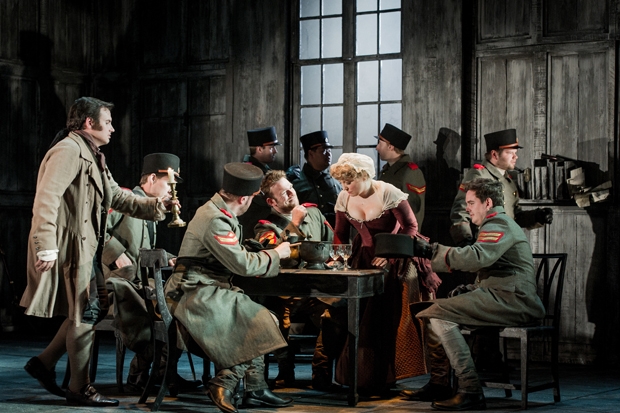Leonore is the first version of Beethoven’s Fidelio, and Stephen Medcalf thinks it’s better. ‘What Leonore gives us is more discursive but more dramatic,’ he declares in the programme of this Buxton Festival production. Well he would, wouldn’t he? He’s the director. You’d hope he’d have some faith in the piece. And what’s undeniable is that with Leonore you get more Beethoven for your buck than in Fidelio. True, there’s no ‘Abscheulicher!’ and no glowing declaration of universal brotherhood from the Minister. But if you’ve ever wished that Beethoven had given us a bit less of all that freedom and humanity stuff and a bit more romantic comedy, Leonore is the version for you, as Beethoven spreads Marzelline, Fidelio and Jacquino’s ditzy domestic love triangle over two leisurely acts.
To be fair, the differences extend throughout the work. Fidelio, in the increasingly rare event of an adequate production, can feel like being caught in a tractor beam, with everything pulling towards the exultant sunlight of Beethoven’s final scene. The finale of Leonore is less stable both in pace and tone, with a revolutionary mob storming the prison and demanding Pizarro’s blood. And those rambling domestic scenes do shift the overall focus of the piece to something closer to its original subtitle, The Triumph of Married Love. Perhaps with pacier direction — in the dialogue-heavy first two acts, at any rate — Leonore might emerge in its own right as the more ambiguous, more richly characterised work Medcalf describes.

I Capuleti e I Montecchi (Photo: Robert Workman)
The designs, by Francis O’Connor, place the action at the time of composition. That’s logical, and those Napoleonic tailcoats certainly look handsome. But having gone for realism, Medcalf’s occasional flashes of artifice are unsettling: the ensemble suddenly holding position and singing ‘Mir ist so wunderbar’ as if in freeze-frame, or Hrolfur Sæmundsson’s growling Pizarro forcing his soldiers into a faintly kinky blood-brotherhood ritual. The Buxton audience giggled awkwardly at the climactic moment when Leonore (Kirstin Sharpin) removes her disguise to reveal herself as Florestan’s wife, and time and again a committed cast (plus a spirited orchestra under Stephen Barlow) finds itself on the wrong side, emotionally, of one of Medcalf’s visual gimmicks.
Sharpin’s voice, boyish and bright in the earlier acts, opens out thrillingly in the high drama of the dungeon scenes. Scott Wilde has both vocal and physical gravitas as Rocco, and a lot more could surely be found in this character, who genuinely does seem more complex in Beethoven’s first draft. You have to wonder just how seriously Medcalf really does take Leonore — not least because of an embarrassing framing device that has David Danholt’s Florestan miming away as Beethoven in full mad-genius mode during the overture, and then resuming that persona in the final moments. What, so Beethoven meant this whole tremendous human drama, the masterpiece with which he wrestled for a decade, as a metaphor for creative block? Memo to directors: it’s not all about you.
Still, Buxton specialises in rarities, and if nothing this summer is quite as succulent as Charpentier’s Louise last year, Leonore was an infinitely more thought-provoking choice than yet another example of that bane of modern operatic life, the rediscovered Donizetti turkey. Buxton’s one specimen of bel canto this year is also rewarding: I Capuleti e i Montecchi, the Bellini melodrama that’s emphatically not based on Romeo andJuliet, in an efficient contemporary updating by director Harry Fehr. The setting is a Camp Bastion-like fortified compound. Guelphs versus Ghibellines become militarised state versus black-clad insurgents, and the whole thing is given wings by the urgent, poetic conducting of Justin Doyle and a terrific pair of lovers: Stephanie Marshall’s coltish Romeo and Sarah-Jane Brandon as a Giulietta whose pure, exquisitely controlled singing quivers with quiet emotion.

Handel’s Tamerlano (Photo: Robert Workman)
Musical values are equally high in Francis Matthews’s production of Handel’s Tamerlano. As Laurence Cummings and the English Concert dance, lilt and languish in the pit, the cast throw off Handel’s vocal fireworks with an ease that borders on nonchalance. Just a generation ago, to hear an account of a Handel opera as graceful, as nuanced, in fact as consistently beautiful as this would still have been a matter of luck.
But as Handel’s semi-legendary figures sauntered on and off in lounge suits and dressing-gowns, I realised, perversely, that I’d like to have felt a bit more danger: slightly wilder flights of exotic rage from Rupert Enticknap’s barbarian emperor Tamerlano, a little less poise from Marie Lys’s luminous Asteria, and perhaps direction that felt closer to an epic tragedy than a camp soap opera. Paul Nilon’s raw performance as Tamerlano’s vanquished rival Bajazet provided the main piece of grit around which this pearl might have coalesced, though audiences in 1724 apparently found it bizarre that a heroic character should be sung by a tenor rather than a castrato. This production, however, needs to grow a pair.






Comments